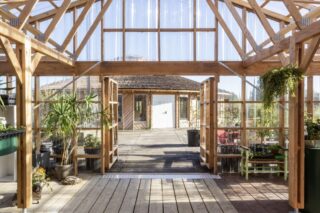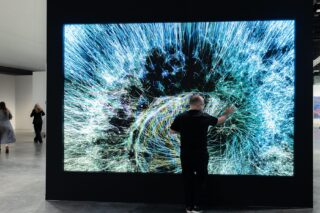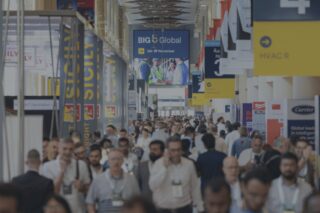“I haven’t felt this positive in years,” Italian designer Ludovica Palomba said in regards to the energy at this year’s Salone del Mobile and Milan Design Week.
Indeed this year’s event sent steady vibes of positivity, and the streets of Milan once again welcomed international and local design seekers who could be nothing but enthusiastic. ArchiExpo e-Magazine toured the fair and the city to discover the latest goings-on. We spoke to the most celebrated Czech designers, discovered a number of young talents in the exhibition SaloneSatellite, were blown away by the exhibition “Women at Work: Interiors for Lago”, went through the Workplace 3.0 exhibition “A Joyful Place to Work” and more.
SaloneSatellite: Young Resilient Creatives
Giant wooden letters spelled SaloneSatellite and hung from the wall separating the exhibition from the halls for Workplace 3.0. Golden hinges connected the two halves of each letter so that guests could change the angle at which the letters popped off the wall. As I was on a global quest for upcoming young designers, meaning more youth and playfulness, this entrance seemed delightfully appropriate.
On the first day of the fair, in the early morning, I caught sight of one of the most eye-grabbing stands with subtly exquisite shades of green, red, purple, pink, orange and blue. Every detail in the products exhibited and the creation of the stand itself portrayed an eye for quality and motivation for perfection. The handiwork for both the products and the stand design belongs to Studio Finna, a young and emerging team of three Helsinki designers.
Listen to them talk about their studio, launched only one year ago, and their collaboration in the Soundcloud clip below.
Design is problem solving, reason and innovation. Throughout the young designers exhibition, several products and stands really stood out. Here are some of our other favorites:
Belgium is Design put on a collaborative exhibition with several of its finest young designers, notably Nicolas Brevers whose geometric, origami-style was fun, interactive and just beautiful. He makes his products by hand, too.
“I’m inspired by the golden ratio and geometric forms, but mostly harmony and balance,” Brevers told ArchiExpo e-Magazine.
 Italian designer Camilla Brunelli presented a number of interesting objects, including a flooring solution called Riflessi which uses the rare material pastina. Her Riflessi project reworks the traditional pastina by adding recycled circular glass elements. Light is meant to reflect off the glass and create movement within the room.
Italian designer Camilla Brunelli presented a number of interesting objects, including a flooring solution called Riflessi which uses the rare material pastina. Her Riflessi project reworks the traditional pastina by adding recycled circular glass elements. Light is meant to reflect off the glass and create movement within the room.
Another interesting product was Metamorphosis, inspired by her drawings. She collaborated with glass maker Simonen Crestani, who did an incredible job bringing her drawings to life.
“The body of the bowl or vase resembles the body of the insect situated on top,” Brunelli told ArchiExpo e-Magazine.
Studio-Y2 from Tokyo presented its Kabin Lounge Chair. Having taken a seat, ArchiExpo e-Magazine confirms it is very comfortable.
WAY ON is a collective initiative developed by the 3rd and 4th year students of the Degree in Design at EINA School of Design and Art of Barcelona, and coordinated by professors Javier Nieto and Oriol Ventura. Two prototypes created for this collaborative project seem promising: Nomad and Imagiro.
Amazing Designs by Incredible Designers
It’s nearly impossible to name all of the delightful products which were released this year into one simple text; however, we have gathered a few of our favorites found throughout the fair. Many of the internationally acclaimed designers who work with top brands like Laufen, Moroso, CoEdition, ClassiCon and more, exhibited products at various stands.
ClassiCon showcased new objects by elite designers, including the Lantern Light by Neri&Hu, the Pli Table by Victoria Wilmotte and the Tadaima Console by A+A Cooren. The Tadaima Console leans up against the wall and is used as a small waist-high table.
Paris brand CoEdition released the You sofa by Luca Nichetto, a very beautiful and comfortable design.
Patricia Urquiola designed a few new products for Moroso, notably the Step sofa. She also worked on Moroso’s M’Afrique collection in 2009, which is still just incredible. The collection had an experimental update with David Weeks Studio’s Amaca. Their new products such as the Meadow by Tord Bootnje, Bell Lab by Ron Arad, Tent by Benjamin Hubert, among others, seemed to enhance the beauty of the older products like the Shadowy chair by Tord Boontje featured below.
Cross-breeding seems to be a theme. The Diesel Living with Moroso exhibition presented new products in the collection. The brand took a journey through Arizona, took photos as they traveled and had the photos printed on fabric which they used for the sofas and chairs. Customers can decide if they want the image printed on the entire chair or select sections. Interesting concept.
Emerging Italian designer Federica Biasi presented new products for Mingardo, Durame and Incipit with S.Bonanni. She develops ceramic tableware, textile products and furniture, while also acting as a creative consultant for design companies such as Fratelli Guzzini.
Czech Selection exhibited products from top local designers, chosen specifically to represent their country in Milan. The small group of six had promising solutions and fun objects to check out. Amos Design showed its Santini quiet point; Dechem showcased its glass tableware and lighting; Qubus presented its Hands Up collection.
Check out the latest sofas exhibited on ArchiExpo.
Workplace 3.0: A Joyful Sense at Work
The biennial exhibition Workplace 3.0 always includes an installation created by invited designers in order to generate reflection on workplace design. A Joyful Sense at Work offered the opportunity to four internationally renowned architectural practices selected for geographic diversity, to produce their vision of the office of the future while incorporating cultural characteristics of their area.
All four did an amazing job portraying their locale while presenting workplace design solutions. The Netherlands is among the most densely populated countries on Earth, so it made sense that Holland studios UNStudio and SCAPE came up with the idea of their single-person pods, RESET, in which individuals can boost their energy or relax their nerves to release stress, whatever is needed.
RESET—Responsive Emotional Transformation—is a totally immersive and modular system that draws on two of the six scientifically proven ways of reducing stress in a playful and interactive way: intimacy, which inspires calm, and sound therapy.
However, in an office of 200 employees, where a one-per-pod situation would create stress to get to the pod before your 199 colleagues, it might prove difficult to render this prototype a preferred solution. Perhaps the studio will come up with a way to adapt the pods to such large companies.
Iran-based Ahmadi Studio drew inspiration from the Persian garden, an intimate and private space and the bazaar, a place of exchange and discussion.
“When in Rome.” Italy’s Studio 5+1AA chose to focus entirely on local architectural norms for its workspace Chronotopic System. They developed a meeting room and an intimate space which recalls the patio of a Mediterranean home.
Based in San Francisco, where just outside the city nature lovers can quickly run into the woods, Studio O+A had guests do just that. They created a four-station journey through the forest entitled The Water Cooler. The studio seems to have come up with a potentially perfect workplace solution for today’s concerns.
They split their space into five rooms, each designated for one or two activities: working, building creativity, relaxing. The largest room seemed to signify the idea of a watercooler, a circular pool of water projected onto the floor. This area emphasizes the importance of postural activity—crouching, lying down, standing up, moving—and helps workers’ creativity to flow like water. The second largest room proposes a solution for communal relaxation, where a continuous sofa runs around the edge of the entire space, with a backrest angled to perfection.
Women at Work: Interiors for Lago
“Never stop living kindness” was the slogan for the exhibition Women at Work: Interiors for LAGO, probably the most successful exhibition at the fair. The brand selected eight Italian women who work in various sectors of society to define kindness and then devoted one interior to each.
“Starting with the conviction that kindness in the work world is about offering the opportunity to work in the best place and way for each individual, the interior dedicated to the women of Intesa Sanpaolo takes the form of a complete house, tailored to women and designed for ‘working smart’ and hosting work and family life in a setting that is devoted to concentration and wellbeing,” according to LAGO.
The collaboration with all eight women, a ballet dancer, a writer, an architect, a creative director, an athlete, an entrepreneur, communication manager and the president of Fondazione Bellisario, allowed LAGO to design seven interiors which portrayed kindness.
“At the Salone, we presented 7 rooms; the 8th will be presented in our showroom soon, dedicated to Lella Golfo. So there are eight interiors and eight women, but the 8th room is about to come,” Federica Berti, press agent, told ArchiExpo e-Magazine.
Each room had its charm, fitting a particular woman’s lifestyle and personality. Walking into the room White Reflections for Carla Fracci, the ballet dancer, there was no mistaking whose room this was. Fracci defines kindness as giving to others.
“No one knows everything. Everyone knows something.”
LAGO mentions this philosophy in its press pack, proudly putting forward its partnerships with brands such as Christian Fischbacher, Miele, Fondazione Bellisario, Philips, Lancome and many more. Kindness involves sharing and building one another up for the better of all. LAGO continues down the path of contributing kindness through its quality products.
Learn more about their new products here.
RE:CHARGE Café: Engineering Nature
Humanscale collaborated with American designer Todd Bracher on the RE:CHARGE Café, a café that had a constant flux of activity throughout the Milan design week. As a design firm and manufacturer of ergonomic products that improve health and comfort at work, the company presented Bracher’s design for a new table typology which focuses on the circadian rhythm. An adjustable light system that matches the natural need for light following the sun’s rotation was installed in the tabletop.
The product stems from scientific research on the human body’s need for a certain intensity of natural light at a certain time. It also evokes the consequences of our move away from natural lighting flows, which can exacerbate disease.
Listen to Todd Bracher talk about the experimental tabletop and Trea chair in the Soundcloud clip below. He also discusses an important point in regards to LED lights.
“Humanscale is ten years ahead of everyone else,” Todd Bracher told ArchiExpo e-magazine after his presentation.
Bracher explained how the company uses processes and materials that are sustainable and ecological for all of their products.
“The plastic used to manufacture the Trea chair comes from plastic waste, generally from the ocean, and every piece of the chair can be recycled.”
The RE:CHARGE café expressed the Humanscale philosophy of putting sustainability of both design and materials at the heart of their work, solving functional problems while consuming less of the Earth’s limited resources. Instead of producing additional plastic in an already very plastic world, Humanscale gathers waste and recycles it into their products.
Humanscale has award-winning office solutions—including self-adjusting seating, sit/stand desks, monitor arms and task lighting—inspire movement and support the user in their every posture.
The team at Humanscale had also contacted London-based forecasting agency and creative consultant FranklinTill Studio, responsible for bringing nature into the design of the café thanks to Vertical Field’s soil-based technology. Indoor and outdoor vertical and horizontal gardens were installed to take visitors beyond the city. Caroline Till from the studio gave a presentation following Bracher and discussed several points, from the psychological importance of color to the need to rethink urban living and the designer’s role in it all.
“Over 70% of the world’s population will be living in cities by 2050,” said Caroline Till.
Listen to Caroline Till speak about engineering nature in the Soundcloud clip below. She presents some of the most interesting projects by designers of our time.
Check out all the products exhibited at the Re:Charge café here.
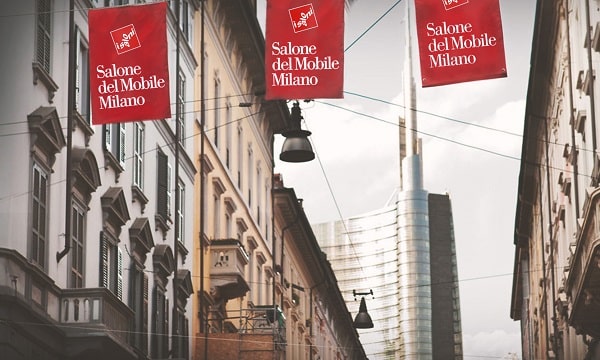
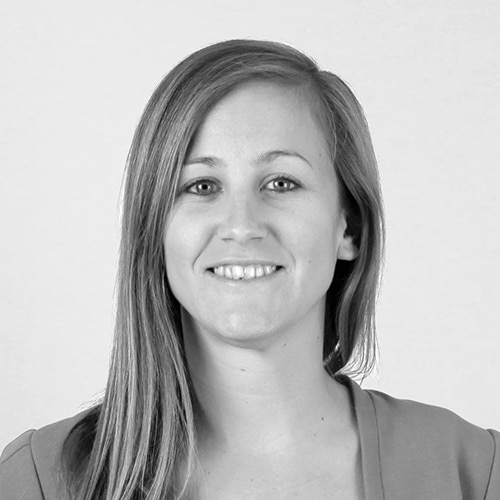





![RESET_07[1]](http://dev-archive-emag.archiexpo.com/wp-content/uploads/sites/7/2017/03/RESET_071-1024x640.jpg)










